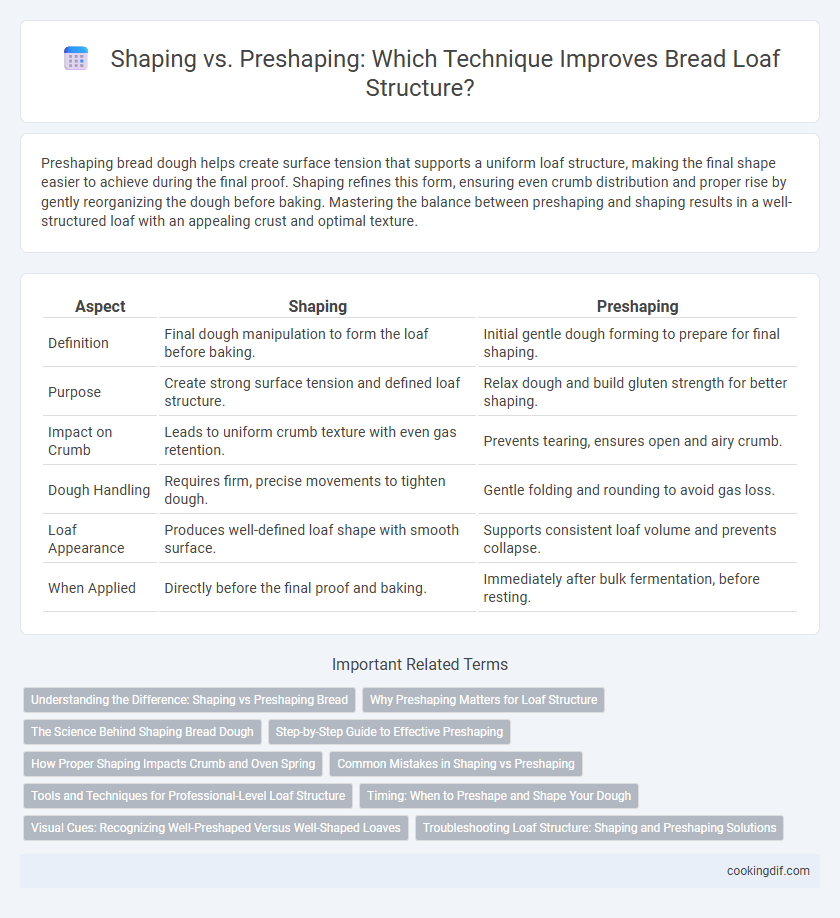Preshaping bread dough helps create surface tension that supports a uniform loaf structure, making the final shape easier to achieve during the final proof. Shaping refines this form, ensuring even crumb distribution and proper rise by gently reorganizing the dough before baking. Mastering the balance between preshaping and shaping results in a well-structured loaf with an appealing crust and optimal texture.
Table of Comparison
| Aspect | Shaping | Preshaping |
|---|---|---|
| Definition | Final dough manipulation to form the loaf before baking. | Initial gentle dough forming to prepare for final shaping. |
| Purpose | Create strong surface tension and defined loaf structure. | Relax dough and build gluten strength for better shaping. |
| Impact on Crumb | Leads to uniform crumb texture with even gas retention. | Prevents tearing, ensures open and airy crumb. |
| Dough Handling | Requires firm, precise movements to tighten dough. | Gentle folding and rounding to avoid gas loss. |
| Loaf Appearance | Produces well-defined loaf shape with smooth surface. | Supports consistent loaf volume and prevents collapse. |
| When Applied | Directly before the final proof and baking. | Immediately after bulk fermentation, before resting. |
Understanding the Difference: Shaping vs Preshaping Bread
Shaping bread refers to the final step of forming the dough into its desired loaf shape before baking, which influences the crumb structure and crust appearance. Preshaping is an earlier, gentler process that organizes the dough's gluten network and redistributes gases, creating tension for a more even rise. Mastering the difference between shaping and preshaping is essential for consistent loaf volume, texture, and an aesthetic, professional finish.
Why Preshaping Matters for Loaf Structure
Preshaping plays a critical role in developing the internal structure of a loaf by creating surface tension that helps maintain its shape during the final proof. This tension supports even gas retention, resulting in a consistent crumb and improved oven spring. Proper preshaping ensures a well-defined loaf with a balanced rise and texture.
The Science Behind Shaping Bread Dough
Shaping bread dough organizes gluten strands and redistributes gas bubbles, which contributes to a uniform crumb structure and optimal oven spring during baking. Preshaping creates a loose initial form that allows gluten to relax, making the final shaping more effective in developing tension on the dough surface. This tension is crucial because it controls expansion and prevents irregular holes, resulting in a consistent and well-structured loaf.
Step-by-Step Guide to Effective Preshaping
Preshaping bread dough helps develop surface tension essential for a well-structured loaf, creating a tighter crumb and better oven spring. Begin by gently pulling and folding the dough to form a loose round, allowing gluten to align without overstressing the dough. Rest the preshaped dough for 15-20 minutes before final shaping to relax the gluten and ensure improved volume and texture.
How Proper Shaping Impacts Crumb and Oven Spring
Proper shaping of bread dough is crucial for achieving an even crumb structure and maximizing oven spring during baking. Tight shaping creates surface tension that helps retain gas bubbles, resulting in a lighter, airier crumb and a higher rise in the oven. In contrast, insufficient preshaping can lead to irregular crumb and reduced volume due to uneven gas distribution and weaker dough strength.
Common Mistakes in Shaping vs Preshaping
Common mistakes in shaping and preshaping bread loaves often include inadequate gluten tension during preshaping, leading to uneven crumb structure. Overhandling dough during shaping can cause degassing, resulting in a denser, less airy loaf. Failing to create a tight skin on the loaf surface before the final proof reduces oven spring and negatively impacts the bread's volume and crust texture.
Tools and Techniques for Professional-Level Loaf Structure
Professional bakers use specific tools like bench scrapers and proofing baskets to enhance loaf structure during shaping and preshaping. Precise preshaping techniques create surface tension that supports even crumb development, while final shaping refines dough tightness for optimal oven spring. Mastery of these steps ensures consistent loaf volume and a well-defined crust, critical for artisanal bread quality.
Timing: When to Preshape and Shape Your Dough
Preshaping dough immediately after bulk fermentation helps relax gluten and even out gas bubbles, setting a uniform structure for the final loaf. Waiting too long to preshape can cause over-fermentation, resulting in weakened gluten and irregular crumb. Shaping should be done after the dough has rested from preshaping, allowing proper tension development for optimal oven spring and loaf volume.
Visual Cues: Recognizing Well-Preshaped Versus Well-Shaped Loaves
Well-preshaped loaves exhibit smooth, taut surfaces with uniform tension, indicating even gluten development and fermentation, while well-shaped loaves show defined edges and an optimal final form that supports oven spring. Visual cues of a well-preshaped loaf include symmetrical folding marks and minimal surface irregularities, signaling proper dough handling before final shaping. Recognizing these characteristics helps bakers predict baking outcomes and achieve loaves with superior crumb structure and volume.
Troubleshooting Loaf Structure: Shaping and Preshaping Solutions
Preshaping helps develop surface tension and a uniform crumb by gently forming the dough into a rough shape before final shaping, which improves loaf structure and oven spring. Shaping refines the dough's form, aligning gluten strands for better rise and crumb consistency, and addressing issues like dense or misshapen loaves. For troubleshooting, if the loaf collapses or spreads too much, increasing preshaping rounds or tightening the final shape can enhance dough strength and support during proofing and baking.
Shaping vs Preshaping for loaf structure Infographic

 cookingdif.com
cookingdif.com